Fantasy Books
Looking Back at RTS – and Myth: The Fallen Lords
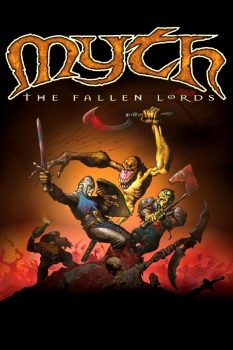 So….one of the rabbit holes I periodically jump down is Total War: Warhammer II. That’s easily my favorite in the Total War series (I played a boatload of TW: I as well. You can use units from I, in II, in some campaigns, which increases the utility of the first game. I appreciate that.
So….one of the rabbit holes I periodically jump down is Total War: Warhammer II. That’s easily my favorite in the Total War series (I played a boatload of TW: I as well. You can use units from I, in II, in some campaigns, which increases the utility of the first game. I appreciate that.
I struggle with the first 15-or-so turns, and frequently abandon a new game, pick another faction, and try again. I like playing different factions, so that’s fine. Also, I often plateau around 70-75 turns, and start a new game as well.
I reinstalled TW: I and II last month and have been playing again. It’s been fun. After a half-dozen false starts, I’m having one of my most successful games leading a chivalry-based, Middle Ages-type faction (WH is a fantasy world, with elves, orcs, beastmen, etc). And I realized I was applying the principles that George Washington advised America about in his famous Farewell Address. Being a Constitutional Convention of 1787 wonk, I’m reasonably familiar with Washington, who presided over the Convention.
However, as I type this right now, it is obvious that such a post is definitely not gonna be ready for tomorrow morning (which would be when this one went live – Monday the 3rd.
And let met tell you, there are multiple elements of Washington’s Address that apply today. Including about people in the country undermining it by pitting one group against another. And that applies to quite a few groups/people…
So instead, we’re talking about a few Real Time Strategy (RTS) games I’ve played over the years. The basic definition of RTS is games that don’t move forward incrementally in turns, but move along in ‘real time.’
The old Warcraft: Orcs and Humans was the first one I really got into, way back in the mid-nineties, which was the birth era of RTS. I never played World of Warcraft, but I ate up the first two Warcraft games (Starcraft followed, and was also immensely popular, but I never tried that one).
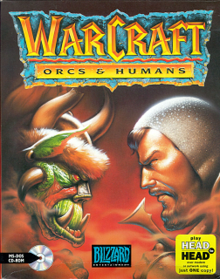 I think I played Command and Conquer for a very short time, but I don’t really remember that. It was kind of a high point of that style of RTS.
I think I played Command and Conquer for a very short time, but I don’t really remember that. It was kind of a high point of that style of RTS.
Age of Empires came along a few years later, and I played the heck out of that, as well as Age of Empires II. Both got rehabs and updates, and AoE II is totally playable. A buddy of mine is still addicted to the new version. AoE II is a classic which is still growing.
A few years ago, my son and I played a LOT of Star Wars: Empire at War, which came out in 2006. It swapped out resource gathering with a point-of-control system. It is a ton of fun.
For a Tolkien fan, Battle for Middle Earth I was fantastic. I didn’t play II, which I’ve heard was even better. It is possible to find an updated version of II that runs on modern Windows, but I haven’t managed to make that happen. Might really dial in on it sometime, and try. I was REALLY good for Tolkien fans.
There was a decent-enough D&D knock-off version, Dragonshard, in 2005. It mixed in a bit more RPG elements. I played it some, but Battle for Middle Earth was definitely superior.
Sid Meier is possibly the greatest game-creator of all time, with Civilization one of the most influential and popular games ever. His first game after leaving MicroProse was Sid Meier’s Gettysburg!, and it is a terrific Civil War game. You need to be totally immersed in it, but it’s a great Civil War game. Sid Meier’s Antietam! was similar.
And Railroad Tycoon was the standard railroad sim for a long time. 2018’s Railway Empire was a blast, and I have played that a fair amount.
I think it’s definitely cool that RTS is not limited to combat games (there are RTS World War games as well – I’ve only dabbled in those). Tropico, and Sim City, are two examples of RTS-type city-building games. I played a LOT of the first Tropico – that’s a fun game.
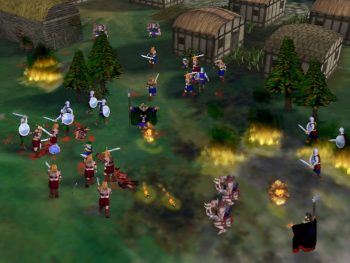 The only game that rivals TW:WH II for me, came out WAAAY back in 1997. Man, how can that be almost 30 years ago? I feel really old. But Bungie’s Myth: The Fallen Lords, was a terrific achievement. Story and game-play: just the EXPERIENCE.
The only game that rivals TW:WH II for me, came out WAAAY back in 1997. Man, how can that be almost 30 years ago? I feel really old. But Bungie’s Myth: The Fallen Lords, was a terrific achievement. Story and game-play: just the EXPERIENCE.
The land has fallen under almost total control of the forces of light (The Fallen Lords), led by Balor. The Light is led by powerful sorcerers, and you control an elite army unit called The Legion. You need to overcome The Fallen Lords. The developers cited Mel Gibson’s Braveheart, and Glen Cook’s fantastic The Black Company (you surely read my interview with him, here), as inspirations.
It is actually an RTT (Real Time Tactical) game. No resource gathering, no settlement growing. You don’t develop skill trees and build up unit strength. You start each scenario with your force fully ready to go.
It was essentially a unit-based combat game (NOT turn-based). But playing it still felt like a combat-based RTS, back then. Terrain and weather impacted things, which was neat at the time. You controlled units (usually in groups) to win battles. And no game I ever played had friendly fire as such a part of it. Those dwarven Molotov cocktails could take out your own forces.
Project Magma has converted the game to operate on current Windows systems. If I could focus in on it, I would probably go through the multiple steps and play this again. But TW: WH I, and II, are already installed, ready to play, and twenty years newer. Still, Myth Lords is one I’m tempted to try.
There was a sequel, and a prequel. But that original game is a masterpiece.

Bob Byrne’s ‘A (Black) Gat in the Hand’ made its Black Gate debut in 2018 and has returned every summer since.
His ‘The Public Life of Sherlock Holmes’ column ran every Monday morning at Black Gate from March, 2014 through March, 2017. And he irregularly posts on Rex Stout’s gargantuan detective in ‘Nero Wolfe’s Brownstone.’ He is a member of the Praed Street Irregulars, founded www.SolarPons.com (the only website dedicated to the ‘Sherlock Holmes of Praed Street’).
He organized Black Gate’s award-nominated ‘Discovering Robert E. Howard’ series, as well as the award-winning ‘Hither Came Conan’ series. Which is now part of THE Definitive guide to Conan. He also organized 2023’s ‘Talking Tolkien.’
He has contributed stories to The MX Book of New Sherlock Holmes Stories — Parts III, IV, V, VI, XXI, and XXXIII.
He has written introductions for Steeger Books, and appeared in several magazines, including Black Mask, Sherlock Holmes Mystery Magazine, The Strand Magazine, and Sherlock Magazine.
Book review: The Devil By Name by Keith Rosson (Fever House #2)

ABOUT THE AUTHOR: Keith Rosson is the author of the novels The Mercy of the Tide and Smoke City, and his short fiction has appeared in Cream City Review, PANK, December, The Nervous Breakdown, and more. He's been twice nominated for a Pushcart Prize and a finalist for the Birdwhistle Prize for Short Fiction. He’s also an illustrator and graphic designer, with clients that include Green Day, Against Me, the Goo Goo Dolls, and others. A fierce advocate of public libraries and non-ironic adulation of the cassette tape, he can be found at keithrosson.com.
Publisher: Random House (September 10, 2024) Length: 400 pages Formats: audiobook, ebook, paperback
The Devil by Name picks up five years after Fever House with all the chaos, gore, and gripping drama you’d expect—and then some. The world is still reeling from “The Message,” a weaponized sound that turned much of humanity into bloodthirsty monsters called the fevered. With Terradyne Industries running the show and humanity clinging to survival, the stakes have never been higher.
The book is a wild ride; it takes elements of horror, noir, and spy thriller vibes and turns them into a splatterfest that somehow still manages to be emotionally grounded. John Bonner, riddled with guilt and desperate for redemption, Katherine Moriarty, coping with devastating loss, and Naomi Laurent, a teenager with a mysterious, world-altering gift, are all struggling. Newcomer Dean Haggerty, a warm, resourceful scavenger, is an unexpected bright spot, bringing a glimmer of hope to a grim story.
Yes, the gore is intense, and the body horror will stick with you long after you’ve turned the last page (looking at you, “tortured fevered in the chair”). But here’s the thing - Rosson knows how to find a balance between the carnage and emotional depth, and his take on grief, redemption, and survival feels raw and real. The character arcs are top-notch, with even minor players leaving a mark. Katherine’s transformation, in particular, is spectacular.
The pacing is relentless, and while some plot conveniences (a possible cure-all across the ocean, for example) might raise an eyebrow, the story’s intensity and emotional pull make it easy to forgive. Rosson ties up loose ends from Fever House while introducing fresh twists, taking the story in surprising directions.
The final chapters are pure nightmare fuel, and the emotional punches hit hard. If you’re into stories that mix terror, heart, and a touch of hope, The Devil by Name delivers big time. It’s the kind of book that leaves you a little haunted but entirely satisfied.
Snake Eyes by Mark Henwick
Urban Fantasy
This is book 8 in the Amber Farrell / Bite Back series. To start at the beginning read the novella Raw Deal or Book 1, Sleight of Hand.

The first four of five books in the series were very much about discovery. Amber Farrell who is vampire, werewolf and witch was learning who she was. All the while battling the bad guys and each supernatural community where she was considered an abomination.
The more recent books have been about joining her separate parts, I guess “becoming” is a good word. And the last couple of books, Queen of Diamonds and Snake Eyes (essentially one book broken into two parts) seem to me to be her arriving at who she is.
This series is honestly one of the best. If you look at the books I read, you’ll notice 90% plus are written by women. Mark Henwick is one of a handful of male authors I read and reread. I’ve probably read most of the books in this series a dozen times. So if you love Urban Fantasy, do yourself a favour. Read Amber Farrell.
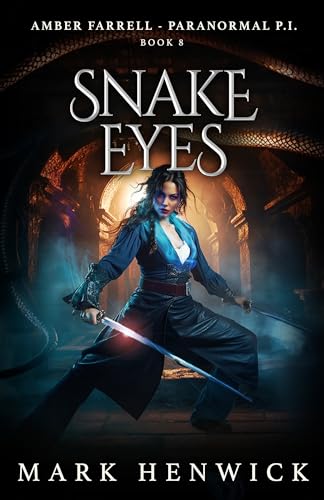
Audiobook Review: Tartufo by Kira Jane Buxton
I received a review copy from the publisher. This does not affect the contents of my review and all opinions are my own.
Mogsy’s Rating (Overall): 3.5 of 5 stars
Genre: Contemporary, Humor
Series: Stand Alone
Publisher: Hachette Audio (January 28, 2025)
Length: 11 hrs and 31 mins
AuthorInformation: Website | Twitter
Narrator: Caroline Hewitt
After thoroughly enjoying Kira Jane Buxton’s Hollow Kingdom series, I was looking forward to checking out Tartufo even though her newest novel falls outside my usual genres. I was mainly curious to see how her quirky sense of humor would transfer to a different kind of story, and while Tartufo does indeed take a more grounded approach, it still carries the author’s signature charm. Still, despite its playfulness and whimsy, the novel didn’t quite capture me in the same way as her previous work.
Set in the small, fictional Italian village of Lazzarini Boscarino, Tartufo tells the tale of a group of residents who will do anything to keep their dying town on the map. With most of the younger generation having departed for greener pastures in the big cities, the remaining aging population is left to hold what’s left of their beloved home together. But the crisis deepens as it is revealed that the previous mayor had died without leaving any available funds for rebuilding and revitalizing. Now his daughter Delizia returns home to handle his affairs only to find herself elected as the new mayor—after nearly losing the race to a donkey—with the unenviable task of turning things around, all the while struggling with her own personal ambitions and disappointments.
Then one day, a local truffle hunter named Giovanni heads out into the forest with his dogs, doing what he loves most, when he suddenly stumbles upon an enormous truffle—quite possibly the largest specimen the world has ever seen. Realizing its potential, Giovanni brings it to the rest of the village, hoping it’s exactly what they need to bring attention back to Lazzarini Boscarino. However, what begins as a stroke of extraordinary luck soon spirals out of control as the attention the town receives also includes that of the negative variety, motivated by enmity and greed. Instead of bringing the community together, the discovery of the truffle threatens do the exactly opposite, forcing everyone to question what future they want for their town.
If you’re looking for some casual reading or a book to sit back and relax with, Tartufo is the perfect choice—relatively low stakes, brimming with charm and wit. For me, it felt a lot like watching a lighthearted musical. The human characters are oddballs, with some portrayals leaning into satire and caricature, filling the cast with over-the-top personalities that wouldn’t feel too out of place in a stage comedy. The novel is also a treat for the senses. Descriptive writing is dialed up to the max, painting a gorgeously evocative picture of the setting. The Italian countryside is described so vividly you can practically smell the delicious scent of food and wine in the restaurants and feel the warmth under the Mediterranean sun. The village of Lazzarini Boscarino is itself as much a character as its eccentric inhabitants, written with the same amount of care and detail.
Buxton has also chosen to tell this story in an omniscient point of view, a brilliant decision which allowed her to do something that has become part of her signature style—writing from the perspective of animals. Inserted between character POVs are scenes told through the eyes of creatures like Giovanni’s truffle-hunting dog, a cat named Al Pacino (despite it being female), and even a passing honeybee. Not only is it reminiscent of the Hollow Kingdom series, which was told through the eyes of a very clever crow, it’s a quirk of the writing which adds an unexpected layer of depth to the story.
Despite the whimsical nature of Tartufo, there’s a distinct lack of supernatural elements, though that alone didn’t take away from my enjoyment. More challenging was the way the narrative juggles so many different POVs, leaving some important characters underdeveloped. It’s also a little too silly in places, making it harder for me to fully immerse myself in the conflict, and there were moments where I wished for more emotional depth.
Nevertheless, Tartufo remains a delightful read, showcasing Kira Jane Buxton’s storytelling abilities. While the playful tone occasionally goes overboard with it and becomes tiresome, on the whole the book is entertaining and endearing. At its heart, it’s a story about togetherness and the dreams of a community, and though I didn’t connect with it as deeply as the author’s Hollow Kingdom, I still had a good time with its humor and themes.
![]()
![]()
The Fiction of Edgar Rice Burroughs, Part II: Tarzan and The Land That Time Forgot
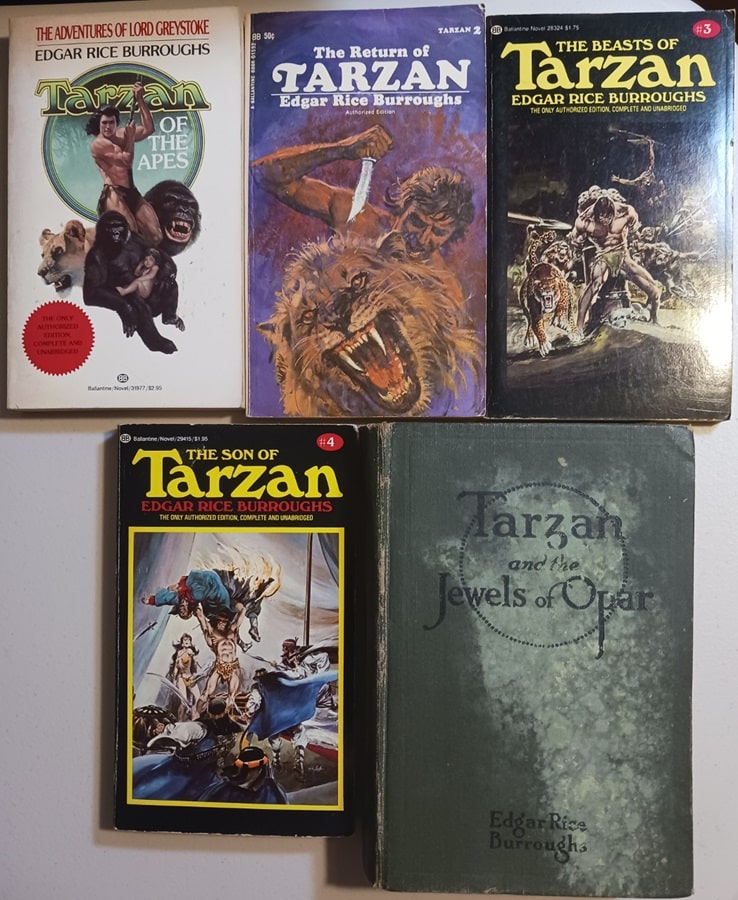 Tarzan novels #1 – #5 : Tarzan of the Apes, The Return of Tarzan, The Beasts of Tarzan, and The Son of Tarzan (Ballantine Books, December 1983, April 1969, April 1975, April 1975), and Tarzan and the Jewels of Opar (A.L. Burt, 1919). Covers by Charles Ren, Bob Abbett, Neal Adams, and Neal Adams.
Tarzan novels #1 – #5 : Tarzan of the Apes, The Return of Tarzan, The Beasts of Tarzan, and The Son of Tarzan (Ballantine Books, December 1983, April 1969, April 1975, April 1975), and Tarzan and the Jewels of Opar (A.L. Burt, 1919). Covers by Charles Ren, Bob Abbett, Neal Adams, and Neal Adams.
Any discussion of Sword & Planet fiction needs to start with Edgar Rice Burroughs and his book A Princess of Mars. I discussed that series extensively — and also his other S&P series, the Carson of Venus books, and his Moon Maid trilogy, which is partially S&P — in Part I of this series.
But, of course, ERB wrote many other books that have no connection to S&P fiction. They are still very good stories, though, entertaining and worth discussing. I thought I’d cover some in my next series of posts.
Most readers I know discovered ERB through the character of Tarzan. The first ERB I read was A Princess of Mars, but the second one was Tarzan Lord of the Jungle. The book was an old hardback, with no dust cover. The cover was generally brown with the title embossed on it. I found it among my sister’s books. She was the only other big reader in my family. I don’t know how she came upon it. I still remember some fifty+ years later the opening scene, with Tarzan dozing on the back of Tantor the elephant. And before long Tarzan finds a lost civilization of crusaders in deepest Africa. And there was swashbuckling.
[Click the images for Tarzan-sized versions.]
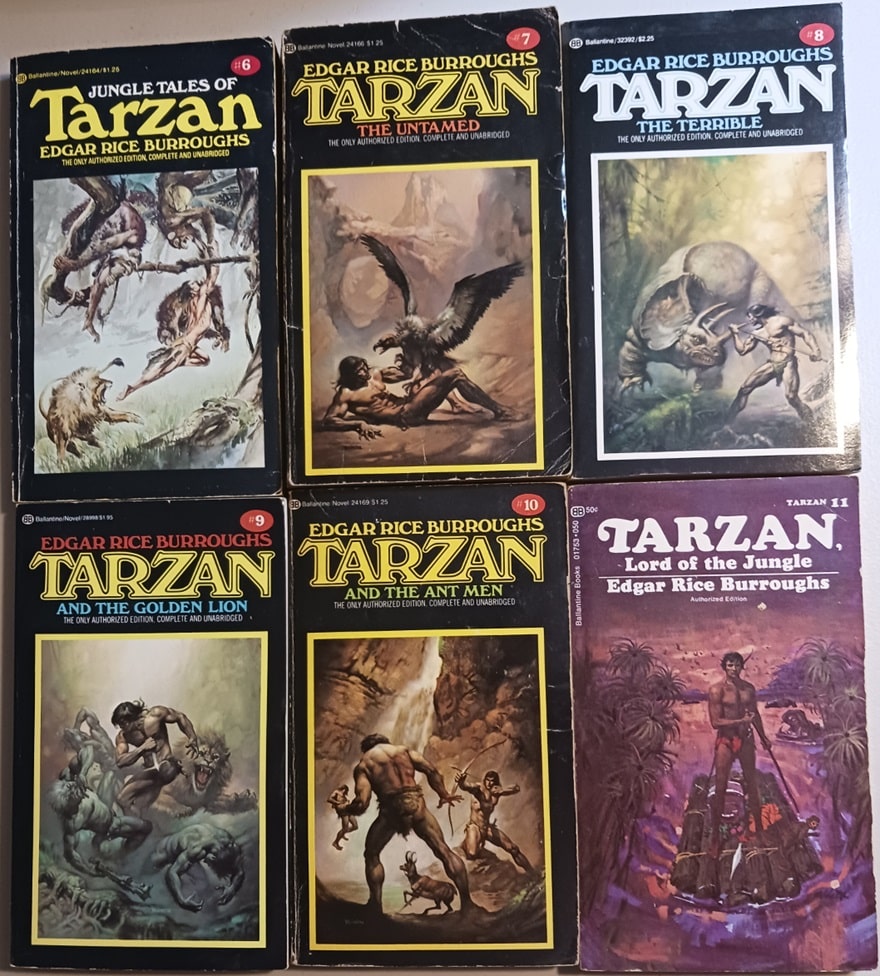 Tarzan #6 – #11: Jungle Tales of Tarzan, Tarzan the Untamed, Tarzan the Terrible, Tarzan and the Golden Lion, Tarzan and the Ant Men, and Tarzan, Lord of the Jungle (Ballantine Books, 1975-1976, and 1969). Covers by Neal Adams, Boris Vallejo, and Bob Abbett.
Tarzan #6 – #11: Jungle Tales of Tarzan, Tarzan the Untamed, Tarzan the Terrible, Tarzan and the Golden Lion, Tarzan and the Ant Men, and Tarzan, Lord of the Jungle (Ballantine Books, 1975-1976, and 1969). Covers by Neal Adams, Boris Vallejo, and Bob Abbett.
I’ve always liked best the Tarzan tales where he discovers a lost race. There were a lot of them in Africa, apparently. That copy of the book fell apart and I eventually replaced it with a paperback. When I started buying the Tarzan books I couldn’t afford to get them all at once, and I also picked up ones here and there from used bookstores or book sales. Most of the ones I found were from the Ballantine editions, many with great Boris Vallejo covers, which became my “mind’s eye” image of Tarzan.
Above I show the first 11 books in my collection. All but Jewels of Opar are from Ballantine, published between 1963 and 1973 it looks like. Covers are varied.
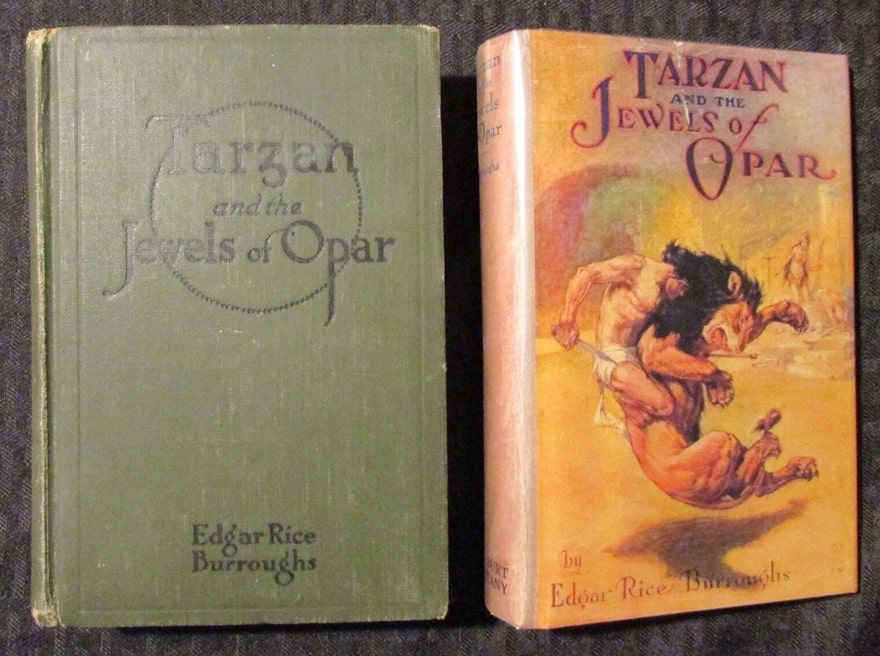 Tarzan and the Jewels of Opar (A.L. Burt Company, 1919). Cover by J. Allen St. John
Tarzan and the Jewels of Opar (A.L. Burt Company, 1919). Cover by J. Allen St. John
Here’s the list of cover artists.
Tarzan of the Apes; Charles Ren
The Return of Tarzan; Robert Abbett
Beasts of, Son of, Jungle Tales of; Neal Adams
Untamed, Terrible, Golden Lion, Ant Men; Boris Vallejo
Lord of the Jungle; Robert Abbett
My copy of Tarzan and the Jewels of Opar was published in 1919 by A. L. Burt Company. It lacks a dust cover, but above is a picture I took off the internet of what it apparently looked like. The beautiful cover is by J. Allen St. John (1872 – 1957), who was an incredible artist.
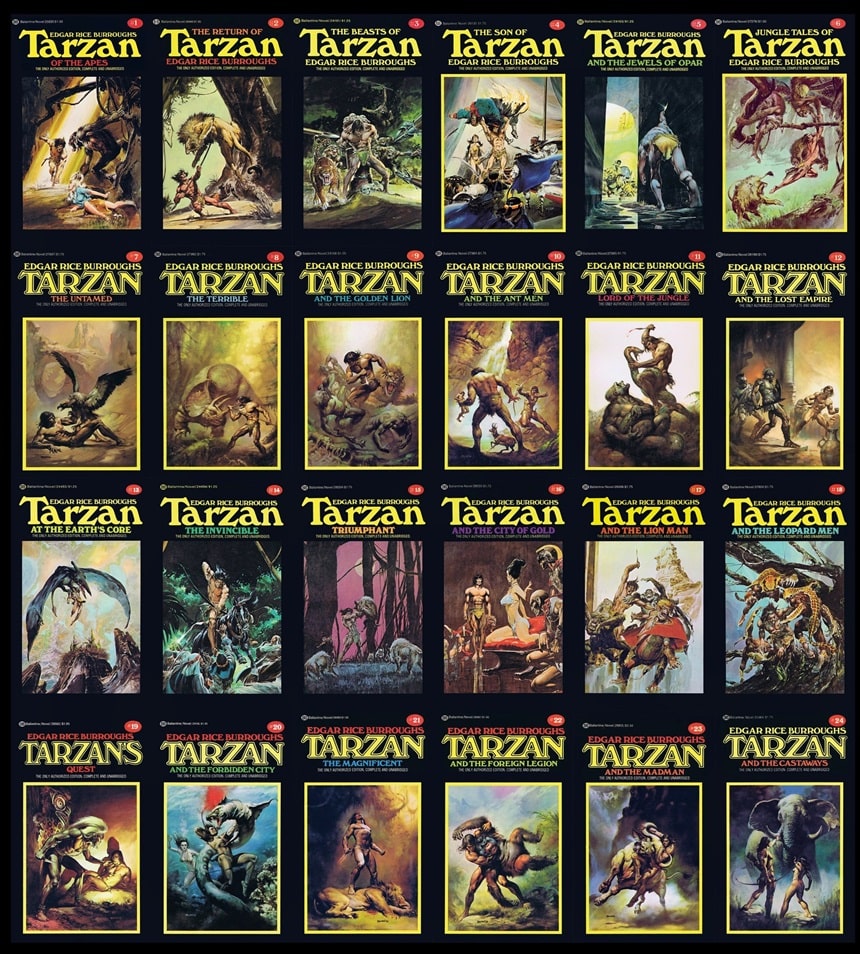 The 24 Tarzan novels and collections published in sequence in paperback by Ballantine Books, 1975 – 1977. Covers by Neal Adams and Boris Vallejo
The 24 Tarzan novels and collections published in sequence in paperback by Ballantine Books, 1975 – 1977. Covers by Neal Adams and Boris Vallejo
Burroughs wrote 26 books about Tarzan, but typically only 24 are counted as part of the main sequence. The two odd numbers out are The Tarzan Twins, which I have, and Tarzan and the Tarzan Twins with Jad-Bal-Ja The Golden Lion, which I’ve never seen. These are novellas written for young readers. They were published separately but were collected together at one point, although I can’t find a copy of that publication.
The copy of The Tarzan Twins that I have is from Wildside Press with a cover by Douglas Grant. It’s the only ERB book I don’t like and doesn’t even seem like ERB to me. ERB’s work was already accessible to young readers. Most people I know read them pretty young, so for him to “try” to write down to kids just didn’t work — at least to me.
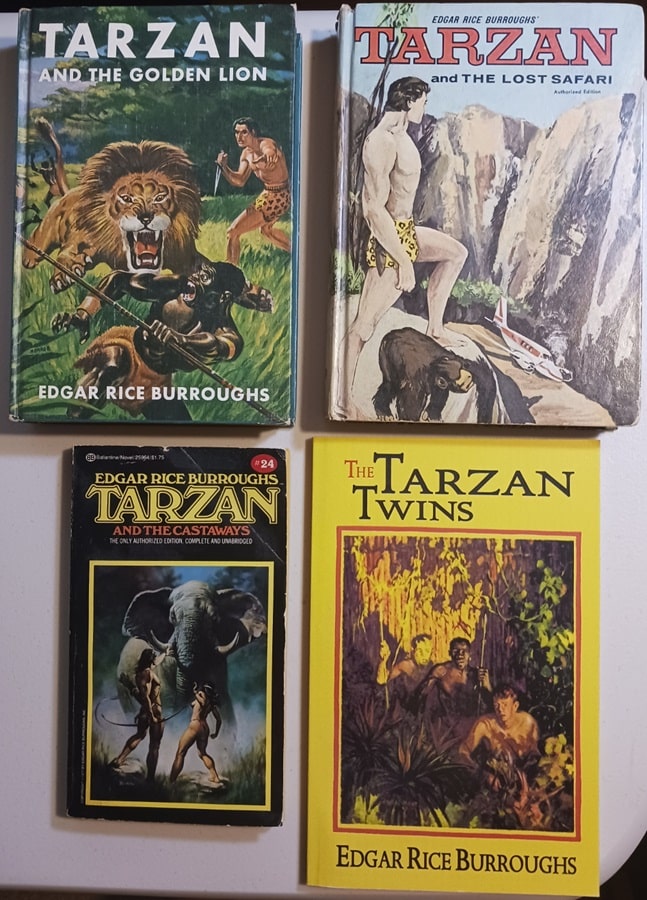 Tarzan and the Golden Lion (Grosset & Dunlap, 1949), Tarzan and the Lost Safari (Whitman Publishing, January 1, 1966, author unknown), Tarzan and the Castaways (Ballantine, September 1977), and The Tarzan Twins (Wildside Press, September 14, 2005). Covers by C. Edmund Monroe, Jr., Tony Sgroi, Boris Vallejo, and Douglas Grant.
Tarzan and the Golden Lion (Grosset & Dunlap, 1949), Tarzan and the Lost Safari (Whitman Publishing, January 1, 1966, author unknown), Tarzan and the Castaways (Ballantine, September 1977), and The Tarzan Twins (Wildside Press, September 14, 2005). Covers by C. Edmund Monroe, Jr., Tony Sgroi, Boris Vallejo, and Douglas Grant.
Overall, the Tarzan series is certainly not my favorite among ERB’s work anyway. They’re actually fairly low on my list of ERB favorites, although — don’t get me wrong — still very good. A ranking of my favorite series would be John Carter, Moon Maid, Carson of Venus, Land that Time Forgot, and Pellucidar, with Tarzan coming after that. Some of my favorite standalones would be The Outlaw of Torn, The Mad King, and I Am A Barbarian.
The Tarzan tales were almost certainly influenced by Rudyard Kipling’s jungle book tales of Mowgli, the wild boy of the forest — which in turn was influenced by some true reports from the mid-1800s of children in India being raised by wolves. ERB may have been directly aware of those same tales as well, and likely knew of the “Wild Boy of Aveyron,” who, around 1800, was found living in the wilds in France. The French feral child was named Victor by one of his “rescuers.” Unlike Tarzan, he never really learned to speak, although he apparently understood some language.
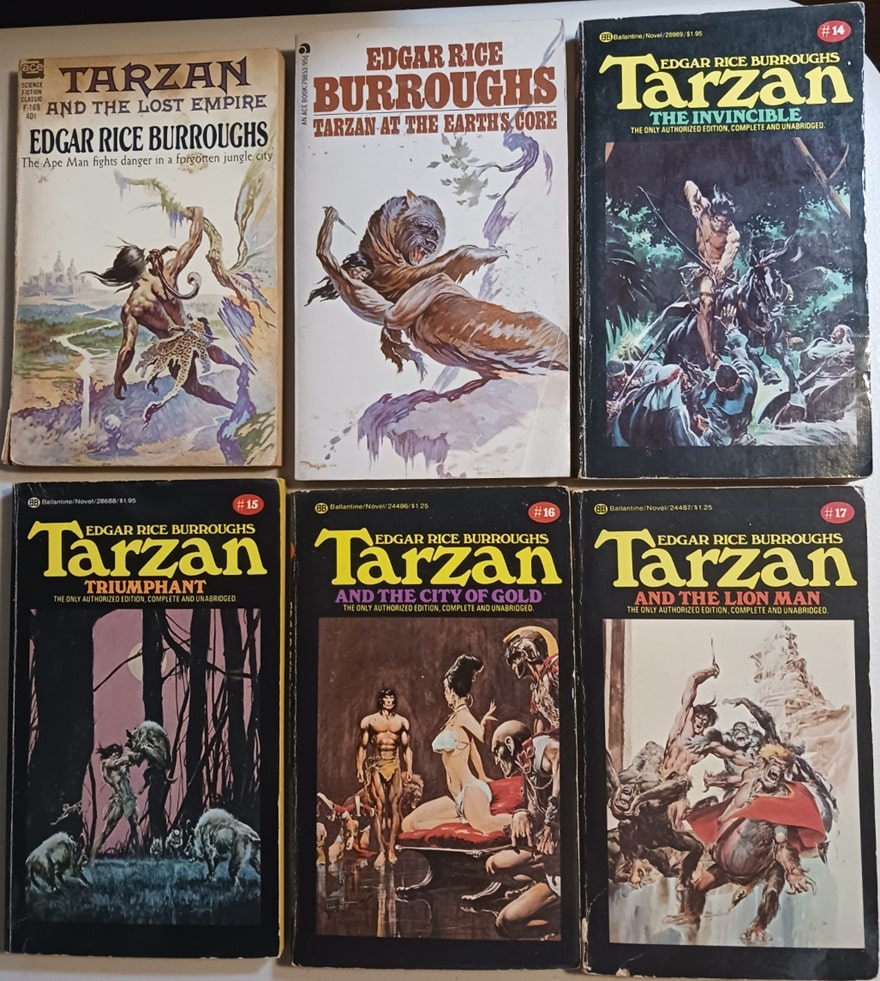 Tarzan #12 – #17: Tarzan and the Lost Empire and Tarzan at the Earth’s Core (Ace Books, November 1962 and March 1963), and Tarzan the Invincible, Tarzan Triumphant, Tarzan and the City of Gold, and Tarzan and the Lion Man (Ballantine Books, November 1975). Covers by Frank Frazetta and Neal Adams.
Tarzan #12 – #17: Tarzan and the Lost Empire and Tarzan at the Earth’s Core (Ace Books, November 1962 and March 1963), and Tarzan the Invincible, Tarzan Triumphant, Tarzan and the City of Gold, and Tarzan and the Lion Man (Ballantine Books, November 1975). Covers by Frank Frazetta and Neal Adams.
Above and below are the remaining Tarzan book pictures from my collection. The Ace copy of Lost Empire with the Frazetta cover that looks like it was inspired by Roy Krenkel Jr’s work is a real prize. I also have an Ace copy of Tarzan at the Earth’s Core, which also ties into ERB’s Pellucidar series, with a wonderful Frazetta cover.
The rest of my regular series are all Ballantine, with the following cover artists.
Invincible, Triumphant, City of Gold, Lion Man, Leopard Men; Neal Adams
Quest, Forbidden City, Magnificent, Foreign Legion, Madman, Castaways; Boris Vallejo
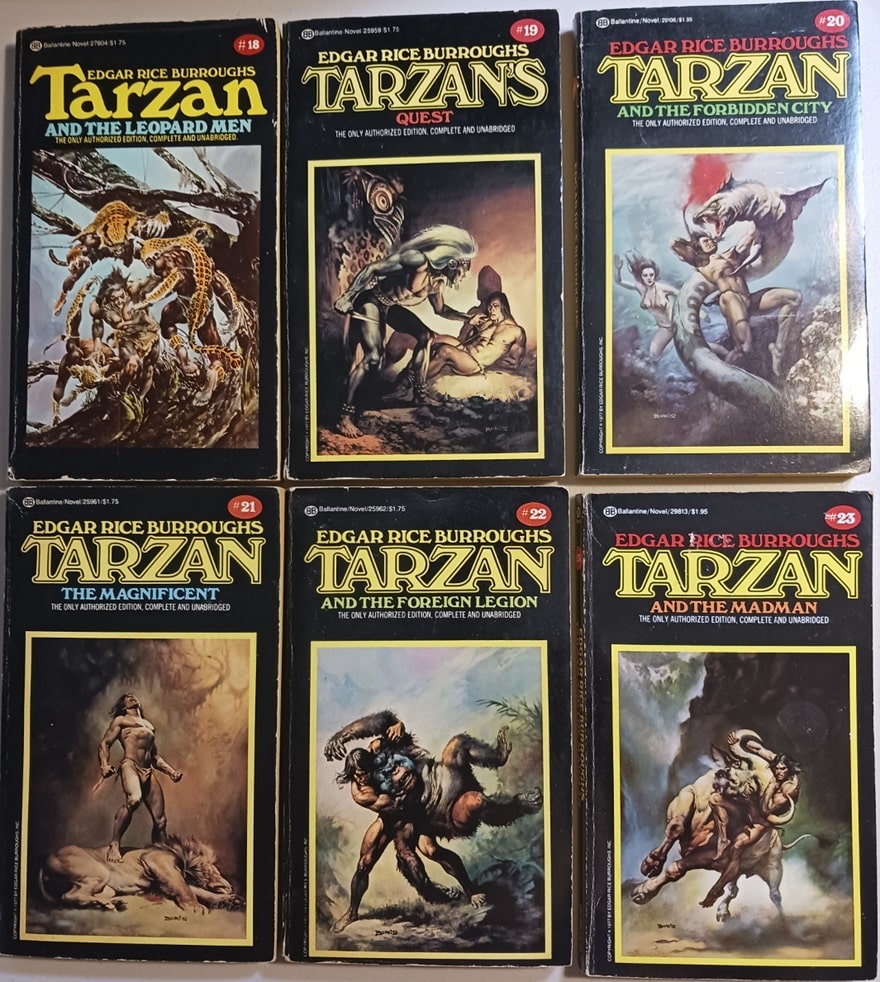 Tarzan #18 – #23: Tarzan and the Leopard Men ((Ballantine Books, November 1975, cover by Neal Adams), and Tarzan’s Quest, Tarzan and the Forbidden City, Tarzan the Magnificent, Tarzan and the Foreign Legion, and Tarzan and the Madman (Ballantine Books, September 1977, covers by Boris Vallejo).
Tarzan #18 – #23: Tarzan and the Leopard Men ((Ballantine Books, November 1975, cover by Neal Adams), and Tarzan’s Quest, Tarzan and the Forbidden City, Tarzan the Magnificent, Tarzan and the Foreign Legion, and Tarzan and the Madman (Ballantine Books, September 1977, covers by Boris Vallejo).
My second copy of Tarzan and the Golden Lion is from Grosset & Dunlap and clearly looks targeted toward younger readers with that cover (see above) — which is pretty cringeworthy for moderns. Not sure when it was published or who the cover artist might be.
Tarzan and the Lost Safari is adapted from the Tarzan movie of that same name. It was published by Whitman and doesn’t list an author, although I’ve seen Frank Castle’s name attached to it. I’ve seen this book for sale as by “Edgar Rice Burroughs.” It’s not. It’s closer to the movie Tarzan than to ERB’s creation. I didn’t find it very entertaining.
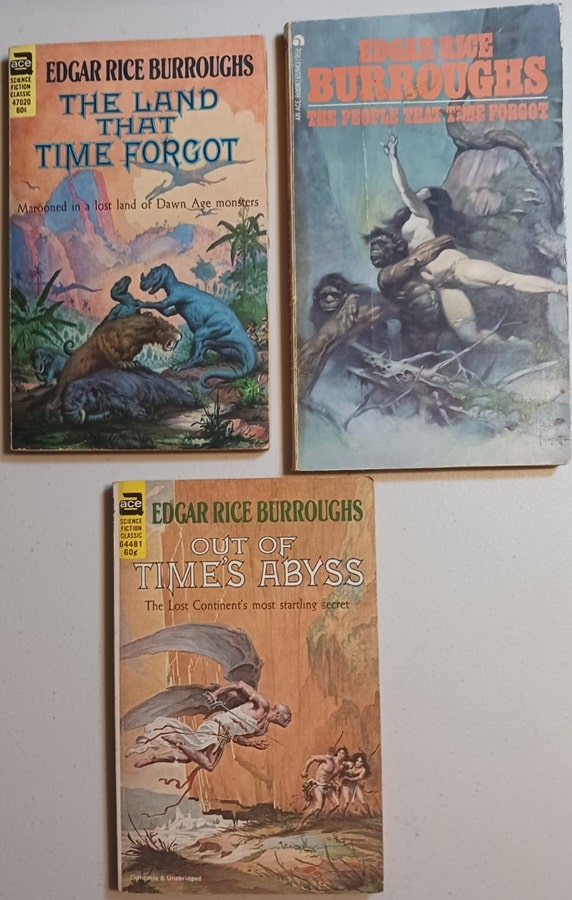 Three novels of The Lost Continent by Edgar Rice Burroughs: The Land That Time Forgot, The People That Time Forgot, and Out of Time’s Abyss (Ace Books, 1963, January 1973, and October 1963). Covers by Roy Krenkel, Jr, Frank Frazetta, and Roy Krenkel, Jr.
Three novels of The Lost Continent by Edgar Rice Burroughs: The Land That Time Forgot, The People That Time Forgot, and Out of Time’s Abyss (Ace Books, 1963, January 1973, and October 1963). Covers by Roy Krenkel, Jr, Frank Frazetta, and Roy Krenkel, Jr.
I personally don’t believe that ERB has been well served by the film and TV industries. I may be in the minority here but I find the early Tarzan movies to be virtually unwatchable. They seem to have very little to do with ERB’s characterization of Tarzan. The first Tarzan movie I actually liked was Greystoke: The Legend of Tarzan, starring Christopher Lambert. It still wasn’t the Tarzan I knew from the books but they made an effort to capture some of the character’s origins. I also liked most of the 2016 Legend of Tarzan, with Alexander Skarsgard, who I believe captured the essence of the character better than any previous Tarzan.
I generally liked the John Carter of Mars film, although they made changes that weren’t needed, but my favorite ERB adaptations are definitely a couple of B-movies starring Doug McClure. I’m talking about The People that Time Forgot, and The Land that Time Forgot. I’ve given these — especially the first one — frequent rewatches. Although the special effects are pretty awful by modern standards, the spirit of ERB’s stories shine through, the mystery and the exotic.
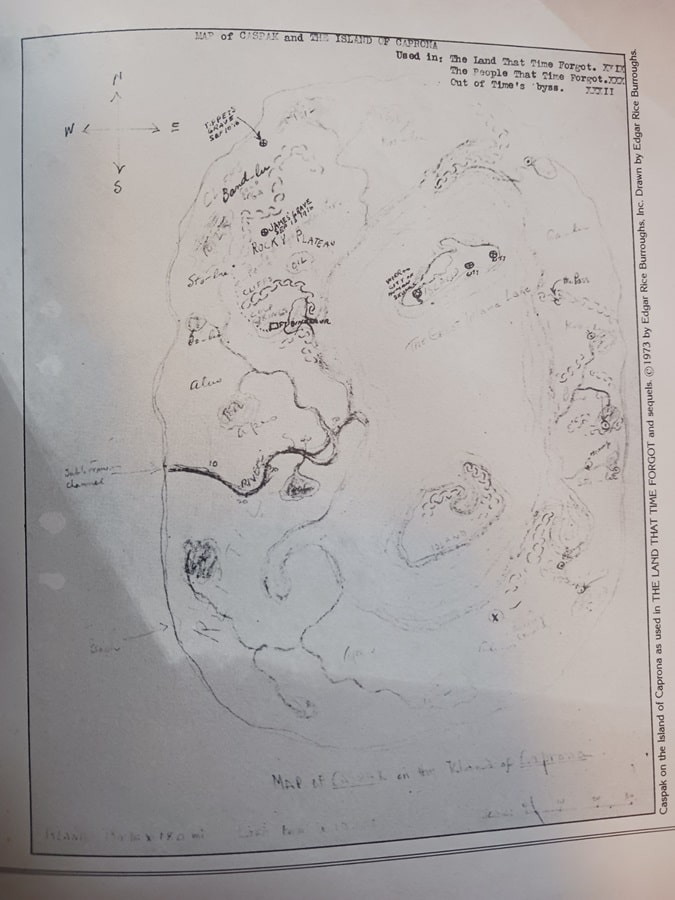 A map of Caprona, the Land that Time Forgot, from An Atlas of Fantasy by J. B. Post (Ballantine Books, 1979)
A map of Caprona, the Land that Time Forgot, from An Atlas of Fantasy by J. B. Post (Ballantine Books, 1979)
Of course, I loved the trilogy that spawned these movies — The Land that Time Forgot, The People that Time Forgot, and Out of Time’s Abyss. I thought Doug McClure did a good job with the character of Bowen Tyler, who becomes the first American to set foot on Caprona, a lost world near Antarctica where time seems to have stopped and dinosaurs still survive. There’s also a deep mystery about how things “evolve” on Caprona, though I won’t give it away.
Above are the three copies I have, all from Ace. Frazetta did the cover for The People while the other two are by Roy Krenkel, Jr. I’m also including a map of Caprona featured in An Atlas of Fantasy.
More on Burroughs next time.
Charles Gramlich administers The Swords & Planet League group on Facebook, where this post first appeared. His last article for Black Gate was The Fiction of Edgar Rice Burroughs, Part I: Sword and Planet.
The Intersection of Hobbies: Dungeons & Dragons, John Eric Holmes, and Tarzan
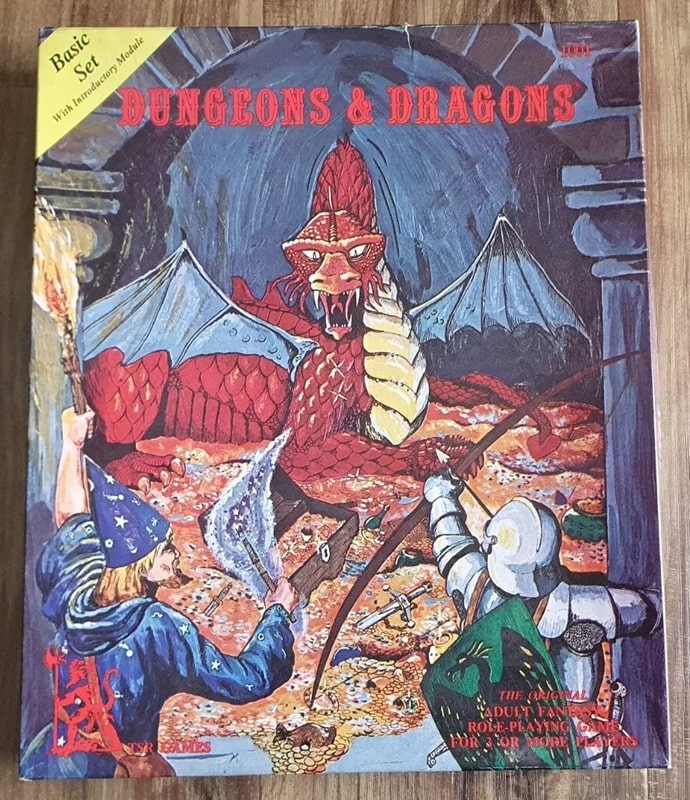 Dungeons & Dragons Basic Set by John Eric Holmes, based on Dungeons & Dragons by Gary Gygax and Dave Arneson (TSR Games, 1977). Cover by David Sutherland
Dungeons & Dragons Basic Set by John Eric Holmes, based on Dungeons & Dragons by Gary Gygax and Dave Arneson (TSR Games, 1977). Cover by David Sutherland
There are many intersections between my favorite hobby (which is also my line of work) and my favorite fiction. One of these intersections is represented by Dr. John Eric Holmes and the fiction of Edgar Rice Burroughs.
When I was a youth, the first Dungeons & Dragons set that I owned was edited by Dr. Holmes. That “basic” set served as the foundation to my understanding of all things D&D. Now, this was in 1981, when I was in the fifth grade. This was also the year in which I was devouring Tarzan novels, written by Edgar Rice Burroughs. My keen interest in Tarzan was fueled by the CBS Saturday morning cartoon, Tarzan, Lord of the Jungle.
[Click the images for Tarzan-sized versions.]
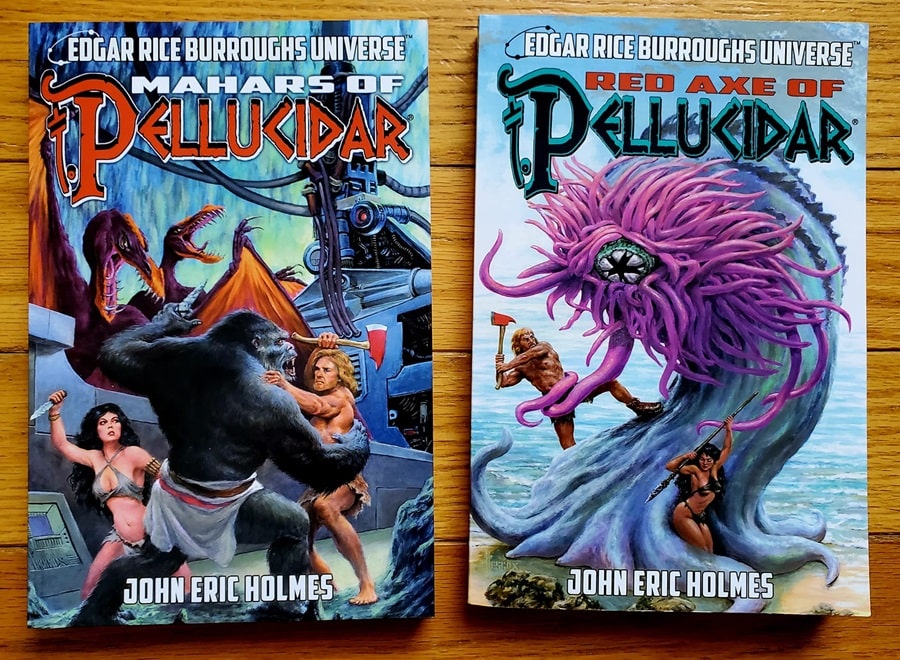 Pellucidar novels by John Eric Holmes: Mahars of Pellucidar and Red Axe of Pellucidar (Edgar Rice Burroughs, Inc., September 6, 2022). Covers by Richard Hescox
Pellucidar novels by John Eric Holmes: Mahars of Pellucidar and Red Axe of Pellucidar (Edgar Rice Burroughs, Inc., September 6, 2022). Covers by Richard Hescox
As I got older, I delved into other works by Burroughs, such as the Barsoom, Amtor, and Pellucidar stories. It wasn’t until recent years that I learned that Dr. Holmes had written two Pellucidar novels himself, the first of which was published in his lifetime, the other which was not: Mahars of Pellucidar and Red Axe of Pellucidar.
I am looking forward to reading these two books soon, probably spaced between my Zelazny readings. It’s nice to see that each of these books includes a foreword by Chris Holmes, one of Dr. Holmes’ children, whom I have had the pleasure to speak with several times at North Texas RPG Con.
 The complete Tarzan novels and collections by Edgar Rice Burroughs, published in paperback by Ballantine Books, 1975 – 1977. Covers by Neal Adams and Boris Vallejo
The complete Tarzan novels and collections by Edgar Rice Burroughs, published in paperback by Ballantine Books, 1975 – 1977. Covers by Neal Adams and Boris Vallejo
When I was young, my first exposure to Tarzan, created by Edgar Rice Burroughs, was the 1966 Tarzan TV series, starring Ron Ely. This was followed by the 1976–1980 animated series, Tarzan, Lord of the Jungle, which really captured my imagination.
I can still hear my brother Bob doing his “Bolmangani” voice from that cartoon. (The Bolmangani were evil gorilla-men that Tarzan often faced.) The show was excellent, and I particularly enjoyed the opening narration:
The jungle: Here I was born; and here my parents died when I was but an infant. I would have soon perished, too, had I not been found by a kindly she-ape named Kala, who adopted me as her own and taught me the ways of the wild. I learned quickly, and grew stronger each day, and now I share the friendship and trust of all jungle animals. The jungle is filled with beauty, and danger; and lost cities filled with good, and evil. This is my domain, and I protect those who come here; for I am Tarzan, Lord of the Jungle!
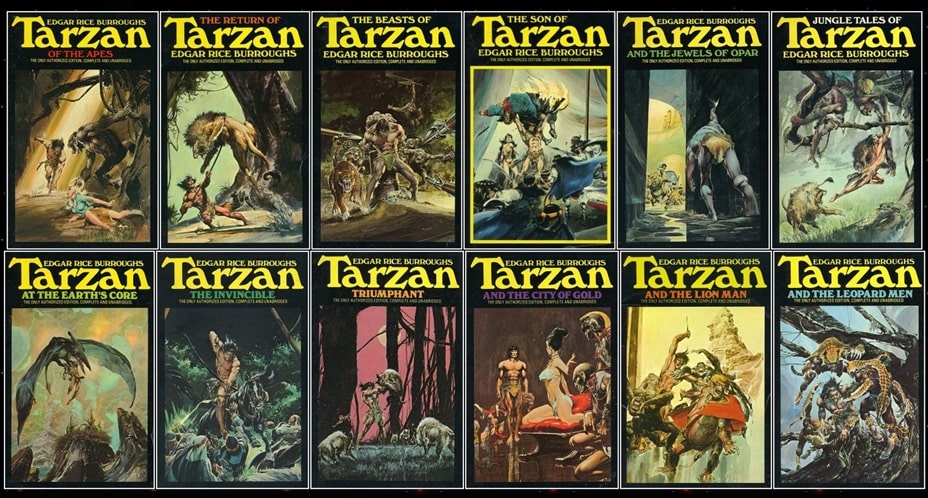 The twelve Neal Adams covers for the Ballantine Tarzan.
The twelve Neal Adams covers for the Ballantine Tarzan.
It was some time around 1981 that I began reading the actual ERB Tarzan books. I was completely enthralled within a few pages. The writing style of ERB was something like I’d never encountered before.
Pictured below is the cover art for the first Tarzan novel that I read, Tarzan of the Apes, published in 1977 by Ballantine Books. It was painted by Neal Adams, whose art was superb. In fact, I am of the opinion that Neal did the finest rendition of Batman to this day.
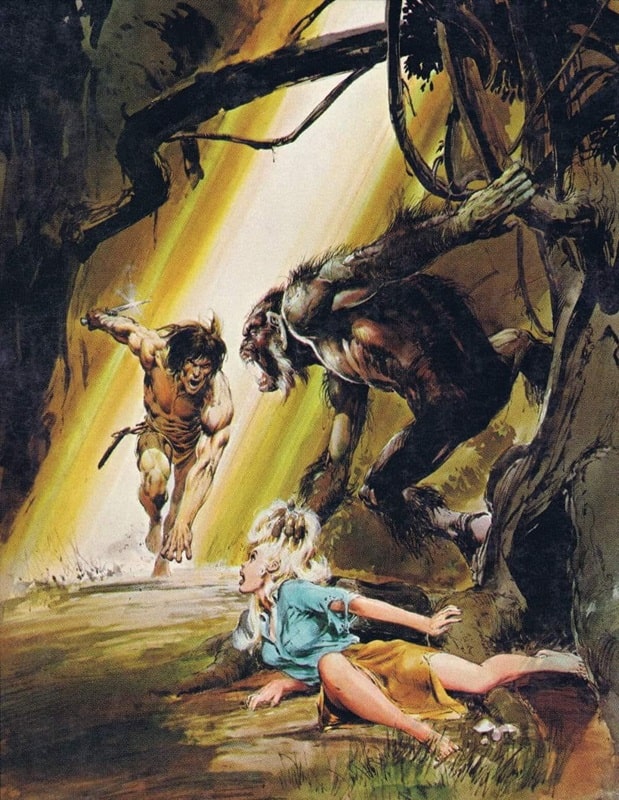 Cover art for Tarzan of the Apes by Neal Adams
Cover art for Tarzan of the Apes by Neal Adams
Anyway, the Neal Adams art is what drew me to purchase the first Tarzan book at my local Walden Books. It led me to a lifelong fascination with the incredibly imaginative works of Edgar Rice Burroughs.
In fact, I can open any ERB book to any random page, start reading, and find myself sucked into a world of wonder.
Jeffrey P. Talanian’s last article for Black Gate was Savage Sword of Conan is Back. He is the creator and publisher of the Hyperborea sword-and-sorcery and weird science-fantasy RPG from North Wind Adventures. He was the co-author, with E. Gary Gygax, of the Castle Zagyg releases, including several Yggsburgh city supplements, Castle Zagyg: The East Mark Gazetteer, and Castle Zagyg: The Upper Works. Read Gabe Gybing’s interview with Jeffrey here, and follow his latest projects on Facebook and at www.hyperborea.tv.
Is Sophie’s Choice a True Story? – Revisiting “Sophie’s Choice”
Is Sophie's Choice a true story? Styron based his novel on his memory of a real-life woman named Sophie, a survivor of Auschwitz he met in Brooklyn.
The post Is Sophie’s Choice a True Story? – Revisiting “Sophie’s Choice” appeared first on LitStack.


Recent comments